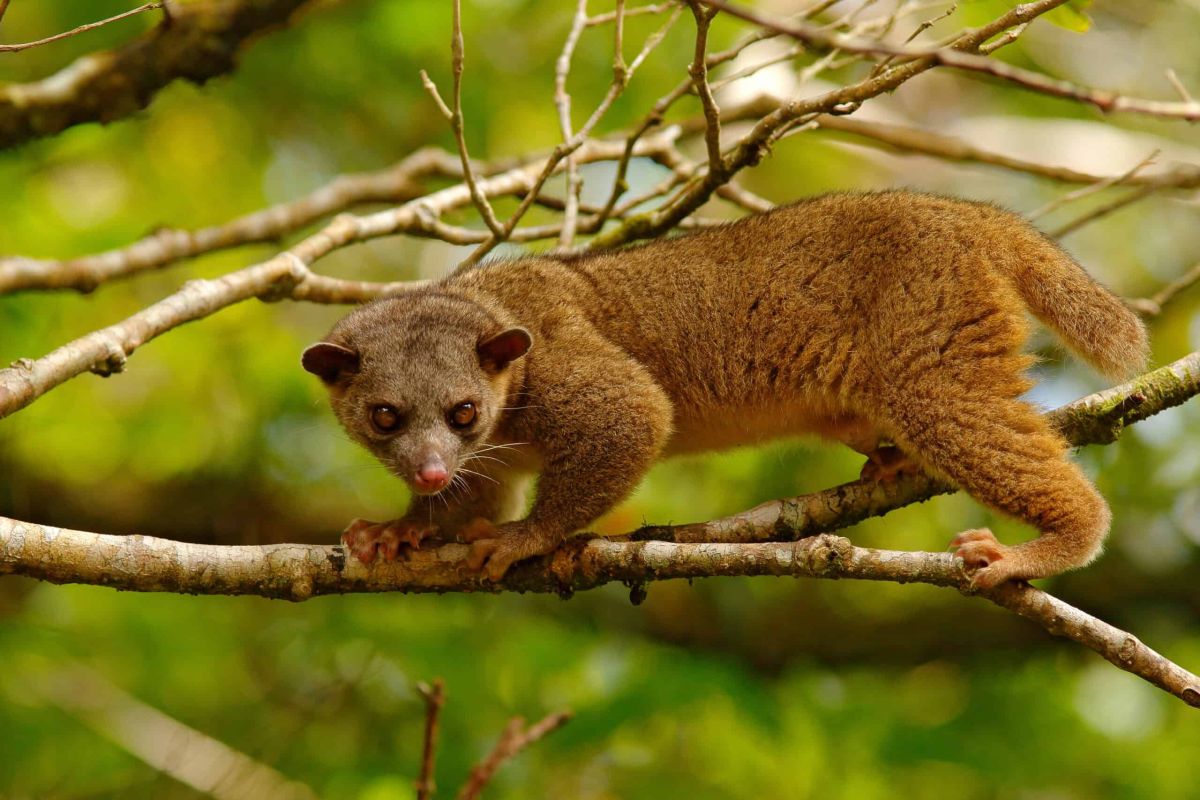Discovering Kinkajous: The Rainforest Treasures

When you think of exotic wildlife, images of majestic jaguars or colorful macaws might come to mind. However, nestled high in the rainforest canopy, another fascinating creature awaits your attention: the kinkajou (Potos flavus). Often referred to as “honey bears” due to their love of sweet treats, these nocturnal mammals are as quirky as they are intriguing. In this article, we will learn about the world of kinkajous, exploring their habitat, behavior, diet, and the conservation efforts that aim to protect these incredible animals.
What Is a Kinkajou?
Kinkajous are small, tree-dwelling mammals belonging to the family Procyonidae, which also includes raccoons, coatis, and olingos. Weighing between 6 to 10 pounds (2.7 to 4.5 kg) and measuring about 16 to 24 inches (40 to 60 cm) in length, kinkajous possess a unique physical appearance. They have large, round eyes, a short snout, and a long, prehensile tail that aids in their arboreal lifestyle. Their fur is typically a beautiful golden-brown, which helps them blend seamlessly into the foliage of their forest home.
Habitat and Range
Kinkajous are primarily found in the tropical rainforests of Central and South America, ranging from southern Mexico down to parts of Brazil. They thrive in areas with dense forest cover and a wealth of fruiting trees. Kinkajous are adaptable creatures, often seen in a variety of forest types, including primary and secondary forests, as well as disturbed areas.
Nocturnal Lifestyle
As nocturnal animals, kinkajous are most active during the night, spending their evenings foraging for food and socializing. They are known for their playful and curious nature, often engaging in acrobatics as they navigate the treetops. Their excellent sense of smell helps them locate flowers and fruits, while their adaptable diet allows them to respond to the seasonal availability of food sources.
Diet and Eating Habits
Kinkajous are primarily frugivorous, meaning they feast on fruits, particularly ripe figs, berries, and various types of nectar. Their long, slender tongues can reach deep into flowers to extract nectar, making them important pollinators in their ecosystem. Additionally, they may consume insects, small vertebrates, and even honey, which has earned them the nickname “honey bears.” Their sweet tooth and ecological role help maintain the health and diversity of rainforest flora.
Social Structure
Kinkajous are generally solitary but may come together in loose family groups or during mating season. These social interactions often involve vocalizations, which can range from soft whines to high-pitched cries, adding to their whimsical charm. Mating typically occurs in the cooler months, with females giving birth to a single offspring after a gestation period of approximately 120 days. The young kinkajous are born blind and helpless, relying on their mother’s care for survival.
Conservation Status
Despite their playful nature and ecological importance, kinkajous face various threats. Habitat loss due to deforestation, illegal pet trade, and hunting jeopardizes their populations. According to the IUCN Red List, kinkajous are currently classified as “Least Concern,” but ongoing threats could lead to further decline. Conservation organizations are working to preserve their habitats, raise awareness, and promote sustainable practices that mitigate the impact of human activity on these delightful creatures.
The Kinkajou in Popular Culture
Kinkajous have garnered attention in popular culture as charming and quirky animals. They often appear in documentaries, children’s books, and social media, captivating audiences with their unique characteristics. However, despite their endearing reputation, potential pet owners should be aware that kinkajous are wild animals with specific needs. They require spacious environments, social stimulation, and a diet that mimics what they would find in the wild.
Conclusion
Kinkajous are not just a delightful curiosity in the rainforest; they are vital players in their ecosystems. By spreading awareness about these incredible animals, we can contribute to their conservation and ensure that future generations can appreciate their charm. Whether you encounter them through documentaries, books, or even in the wild, kinkajous remind us of the beauty and complexity of the natural world. Embracing our role as stewards of the planet will help protect these enigmatic rainforest treasures for years to come.



